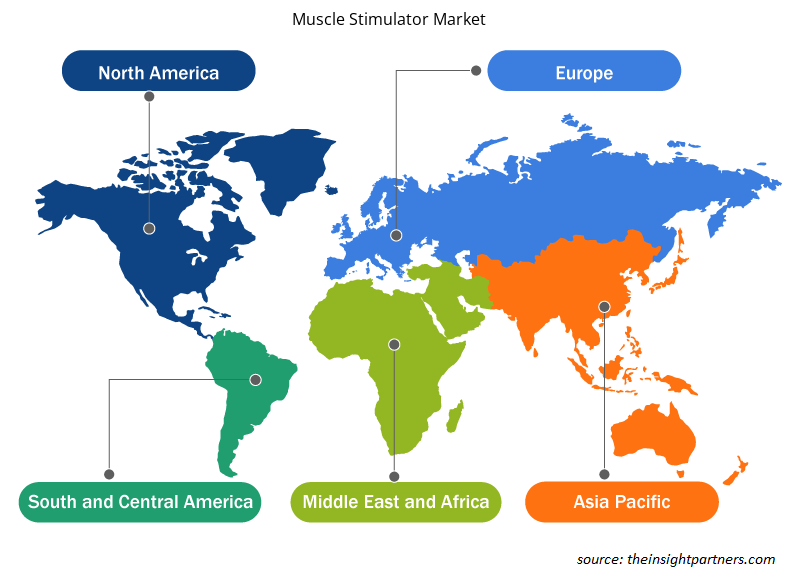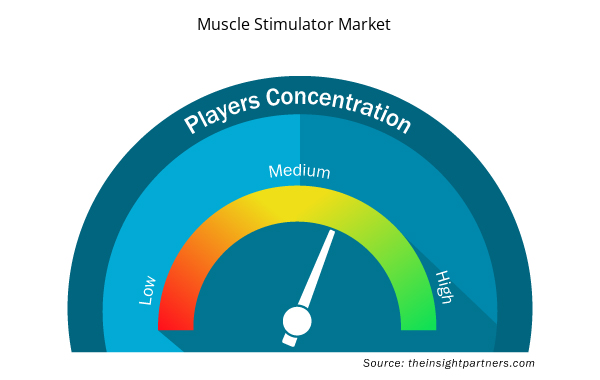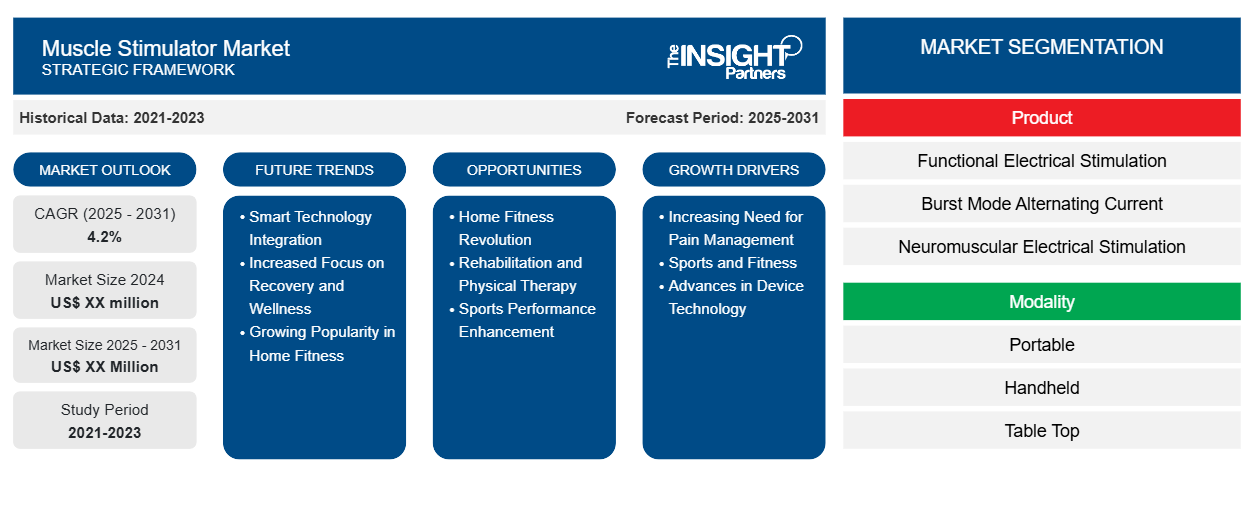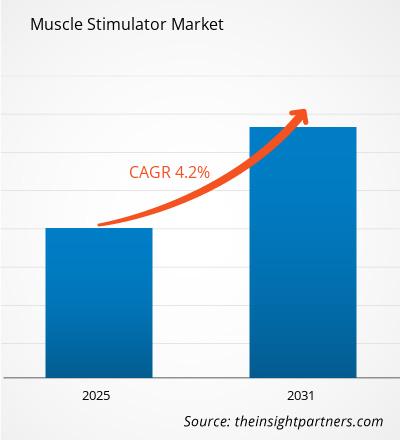Se espera que el mercado de estimuladores musculares registre una CAGR del 4,2% entre 2024 y 2031, con un tamaño de mercado que se expandirá de US$ XX millones en 2024 a US$ XX millones en 2031.
El informe está segmentado por producto (estimulación eléctrica funcional, corriente alterna en modo ráfaga, estimulación eléctrica neuromuscular, interferencial, microcorriente EMS, estimulación nerviosa eléctrica transcutánea y otros productos), modalidad (portátil, de mano y de sobremesa), aplicación (trastorno neurológico, trastorno musculoesquelético, manejo del dolor y otras aplicaciones).
Propósito del Informe
El informe Muscle Stimulator Market de The Insight Partners tiene como objetivo describir el panorama actual y el crecimiento futuro, los principales factores impulsores, los desafíos y las oportunidades. Esto proporcionará información a diversas partes interesadas del negocio, como:
- Proveedores/fabricantes de tecnología: Para comprender la dinámica cambiante del mercado y conocer las oportunidades potenciales de crecimiento, lo que les permitirá tomar decisiones estratégicas informadas.
- Inversionistas: Realizar un análisis exhaustivo de tendencias sobre la tasa de crecimiento del mercado, las proyecciones financieras del mercado y las oportunidades que existen en toda la cadena de valor.
- Órganos reguladores: Regular las políticas y vigilar las actividades del mercado con el objetivo de minimizar los abusos, preservar la confianza de los inversores y defender la integridad y estabilidad del mercado.
Segmentación del mercado de estimuladores musculares
Producto
- Estimulación eléctrica funcional
- Corriente alterna en modo ráfaga
- Estimulación eléctrica neuromuscular
- Interferencial
- Microcorriente EMS
- Estimulación nerviosa eléctrica transcutánea
- Otros productos
Modalidad
- Portátil
- Portátil
- Tablero de mesa
Solicitud
- Trastorno neurológico
- Trastorno musculoesquelético
- Manejo del dolor
- Otras aplicaciones
Geografía
- América del norte
- Europa
- Asia-Pacífico
- América del Sur y Central
- Oriente Medio y África
Personalice este informe según sus necesidades
Obtendrá personalización en cualquier informe, sin cargo, incluidas partes de este informe o análisis a nivel de país, paquete de datos de Excel, así como también grandes ofertas y descuentos para empresas emergentes y universidades.
- Obtenga las principales tendencias clave del mercado de este informe.Esta muestra GRATUITA incluirá análisis de datos, desde tendencias del mercado hasta estimaciones y pronósticos.
Factores impulsores del crecimiento del mercado de estimuladores musculares
- Necesidad creciente de tratamiento del dolor: el aumento de los trastornos de dolor crónico ha provocado un aumento de la demanda de estimuladores musculares. La comodidad de un tratamiento para el dolor, que no es invasivo ni requiere medicamentos, lo hace muy popular. Su eficacia en la estimulación aplicada que calma el malestar mientras se cura estimula tanto a los pacientes como a los profesionales de la salud que prefieren tratamientos fuertes.
- Deportes y fitness: crecimiento de las industrias La mayor conciencia sobre el fitness y las actividades deportivas impulsan la demanda de estimuladores musculares. Las aplicaciones incluyen la recuperación, la mejora de los músculos y el rendimiento de los atletas e incluso de los entusiastas del fitness. Cuanto más engorrosos sean los ejercicios, mayor será la demanda de sistemas de recuperación que sean lo suficientemente efectivos, lo que hace que más estimuladores musculares desempeñen funciones que mejoren el rendimiento y reduzcan el riesgo de lesiones.
- Avances en la tecnología de los dispositivos: Se han logrado muchos cambios en los últimos dos años y es digno de elogio otorgar las calificaciones más altas a la nueva tecnología de estimulación muscular. Se ha mejorado la eficiencia y la experiencia del consumidor mediante el rediseño de los electrodos y otras características de la interfaz de usuario, como la comunicación inalámbrica, las configuraciones específicas para el usuario y muchas otras. Las nuevas tecnologías se dirigirían a una población mucho más amplia de usuarios que desearían estos dispositivos; solo que los cambios podrían realmente adaptar los programas de tratamiento a una población más grande de pacientes que necesitan tales servicios, aumentando así el alcance del mercado.
Tendencias futuras del mercado de estimuladores musculares
- Integración de tecnología inteligente: integración de tecnología inteligente en los dispositivos de estimulación muscular. En la actualidad, cada vez hay más productos de estimulación muscular en el mercado que integran tecnología inteligente para permitir la práctica de terapias personalizadas a través de aplicaciones móviles e incluso algoritmos de inteligencia artificial. Por lo tanto, es posible ofrecer regímenes de tratamiento que son individualizados y varían del tratamiento de referencia para optimizar su eficacia. El monitoreo y la retroalimentación instantáneos también ayudan a mejorar la comodidad y la experiencia, lo que proporciona una ventaja competitiva a los consumidores que tienen altas expectativas de los dispositivos que compran, en particular aquellos que desean los mejores resultados de recuperación y entrenamiento.
- Mayor enfoque en la recuperación y el bienestar: aumento de las regiones enfocadas en la recuperación y el bienestar A medida que el auge de la cultura del bienestar apunta a las tendencias de salud, esto también hizo que las soluciones de recuperación sean aún más pertinentes, de ahí la gran demanda de estimuladores musculares. Quieren encontrar dispositivos que no solo faciliten la recuperación, sino que también ayuden a promover la salud, como la relajación y la reducción del estrés. Esto denota la creación de prototipos que lograrán soluciones de diseño para los sistemas funcionales y de moda que atraerán tanto a los deportistas profesionales como a otros, lo que a su vez crea otros mercados y usos.
- Creciente popularidad del fitness en casa: las tendencias de fitness en casa también están impulsando la demanda de estimuladores musculares que se puedan utilizar sin movilidad asistida. A medida que la gente invierte cada vez más en equipos de entrenamiento para gimnasios en casa más sofisticados, el estimulador muscular portátil se está transformando en un dispositivo eficiente para una recuperación muscular más rápida y el alivio del dolor. Esta tendencia se atribuye aún más a los cambios sociales, que incluyen actividades más amplias de autocuidado y preservación de la salud, y el estimulador muscular es uno de los dispositivos en estas actividades que se realizan en casa.
Oportunidades de mercado para estimuladores muscularesStimulator Market Opportunities
- Revolución del fitness en casa: Los avances en el fitness en casa están en auge y, en este caso, algunos estimuladores musculares de sesenta o más años han brindado una oportunidad única a los clientes que desean ejercitarse con comodidad. Existe la posibilidad de que, a medida que más personas participen en actividades de fitness de manera más efectiva, dichas técnicas mejoren los beneficios del entrenamiento personal entre un mayor número de personas. La mayoría de las empresas que están más orientadas hacia los diseños amigables y logran resultados positivos tienen éxito en este nicho de mercado.
- Rehabilitación y fisioterapia: En los últimos tiempos, se ha producido un cambio de paradigma en la rehabilitación y la práctica de la fisioterapia, lo que crea una oportunidad en el mercado para los estimuladores musculares, ya que estos dispositivos ayudan a la recuperación muscular, así como al alivio del dolor y la rehabilitación de una lesión. Por eso, los pacientes y los proveedores de atención médica se sienten atraídos por los dispositivos que ofrecen estos tres conceptos. Es posible mejorar el valor de los estimuladores musculares como productos de recuperación mediante la colaboración con clínicas y terapeutas en el desarrollo de productos.
- Mejora del rendimiento deportivo: El rendimiento está en constante desarrollo y existen estimuladores musculares que actúan como una nueva dimensión para el entrenamiento de fortalecimiento y resistencia. Dentro del programa de entrenamiento desarrollado, las iniciativas de marketing se dirigirán a los entrenadores médicos y atléticos de los clubes deportivos, entrenadores, equipos deportivos y otros activadores del fitness, mientras que los centros de investigación y desarrollo se centrarán en los atletas profesionales y amantes del deporte para estimular el uso de estimuladores musculares como medios adicionales para alcanzar el nivel de entrenamiento requerido para los campeonatos.
Perspectivas regionales del mercado de estimuladores musculares
Los analistas de Insight Partners han explicado detalladamente las tendencias y los factores regionales que influyen en el mercado de estimuladores musculares durante el período de pronóstico. Esta sección también analiza los segmentos y la geografía del mercado de estimuladores musculares en América del Norte, Europa, Asia Pacífico, Oriente Medio y África, y América del Sur y Central.

- Obtenga datos regionales específicos para el mercado de estimuladores musculares
Alcance del informe de mercado sobre estimuladores musculares
| Atributo del informe | Detalles |
|---|---|
| Tamaño del mercado en 2024 | XX millones de dólares estadounidenses |
| Tamaño del mercado en 2031 | US$ XX millones |
| CAGR global (2025 - 2031) | 4,2% |
| Datos históricos | 2021-2023 |
| Período de pronóstico | 2025-2031 |
| Segmentos cubiertos | Por producto
|
| Regiones y países cubiertos | América del norte
|
| Líderes del mercado y perfiles de empresas clave |
|
Densidad de actores del mercado de estimuladores musculares: comprensión de su impacto en la dinámica empresarial
El mercado de estimuladores musculares está creciendo rápidamente, impulsado por la creciente demanda de los usuarios finales debido a factores como la evolución de las preferencias de los consumidores, los avances tecnológicos y una mayor conciencia de los beneficios del producto. A medida que aumenta la demanda, las empresas amplían sus ofertas, innovan para satisfacer las necesidades de los consumidores y aprovechan las tendencias emergentes, lo que impulsa aún más el crecimiento del mercado.
La densidad de actores del mercado se refiere a la distribución de las empresas o firmas que operan dentro de un mercado o industria en particular. Indica cuántos competidores (actores del mercado) están presentes en un espacio de mercado determinado en relación con su tamaño o valor total de mercado.
Las principales empresas que operan en el mercado de estimuladores musculares son:
- AxioBiónica
- Beurer GmbH
- DJO Global
- EMS Fisio Ltd.
- Meyer DC
Descargo de responsabilidad : Las empresas enumeradas anteriormente no están clasificadas en ningún orden particular.

- Obtenga una descripción general de los principales actores clave del mercado de estimuladores musculares
Puntos de venta clave
- Cobertura integral: el informe cubre de manera integral el análisis de productos, servicios, tipos y usuarios finales del mercado de estimuladores musculares, proporcionando un panorama holístico.
- Análisis de expertos: el informe se compila sobre la base de un profundo conocimiento de expertos y analistas de la industria.
- Información actualizada: El informe asegura relevancia comercial debido a su cobertura de información reciente y tendencias de datos.
- Opciones de personalización: este informe se puede personalizar para satisfacer los requisitos específicos del cliente y adaptarse adecuadamente a las estrategias comerciales.
Por lo tanto, el informe de investigación sobre el mercado de estimuladores musculares puede ayudar a abrir camino para descifrar y comprender el escenario de la industria y las perspectivas de crecimiento. Si bien puede haber algunas preocupaciones válidas, los beneficios generales de este informe tienden a superar las desventajas.
- Análisis histórico (2 años), año base, pronóstico (7 años) con CAGR
- Análisis PEST y FODA
- Tamaño del mercado Valor/volumen: global, regional, nacional
- Industria y panorama competitivo
- Conjunto de datos de Excel



Report Coverage
Revenue forecast, Company Analysis, Industry landscape, Growth factors, and Trends

Segment Covered
This text is related
to segments covered.

Regional Scope
North America, Europe, Asia Pacific, Middle East & Africa, South & Central America

Country Scope
This text is related
to country scope.
Preguntas frecuentes
The muscle stimulator market is estimated to grow with a CAGR of 4.2% from 2023 to 2031.
The muscle stimulator market majorly consists of the players such as AxioBionics, Beurer GmbH, and DJO Global among others.
Asia Pacific region is likely to witness fastest growth rate during the forecast period.
Smart technology integration are likely to remain the key trend during the forecast period
The market drivers include increasing need for pain management and sports and fitness are driving the muscle stimulator market
North America dominated the muscle stimulator market in 2023
Trends and growth analysis reports related to Life Sciences : READ MORE..
1. AxioBionics
2. Beurer GmbH
3. DJO Global
4. EMS Physio Ltd.
5. MeyerDC
6. Omron Healthcare, Inc.
7. RS Medical
8. OG WELLNESS TECHNOLOGIES CO., LTD.
9. Zimmer MedizinSysteme GmbH
10. Zynex Medical
The Insight Partners performs research in 4 major stages: Data Collection & Secondary Research, Primary Research, Data Analysis and Data Triangulation & Final Review.
- Data Collection and Secondary Research:
As a market research and consulting firm operating from a decade, we have published and advised several client across the globe. First step for any study will start with an assessment of currently available data and insights from existing reports. Further, historical and current market information is collected from Investor Presentations, Annual Reports, SEC Filings, etc., and other information related to company’s performance and market positioning are gathered from Paid Databases (Factiva, Hoovers, and Reuters) and various other publications available in public domain.
Several associations trade associates, technical forums, institutes, societies and organization are accessed to gain technical as well as market related insights through their publications such as research papers, blogs and press releases related to the studies are referred to get cues about the market. Further, white papers, journals, magazines, and other news articles published in last 3 years are scrutinized and analyzed to understand the current market trends.
- Primary Research:
The primarily interview analysis comprise of data obtained from industry participants interview and answers to survey questions gathered by in-house primary team.
For primary research, interviews are conducted with industry experts/CEOs/Marketing Managers/VPs/Subject Matter Experts from both demand and supply side to get a 360-degree view of the market. The primary team conducts several interviews based on the complexity of the markets to understand the various market trends and dynamics which makes research more credible and precise.
A typical research interview fulfils the following functions:
- Provides first-hand information on the market size, market trends, growth trends, competitive landscape, and outlook
- Validates and strengthens in-house secondary research findings
- Develops the analysis team’s expertise and market understanding
Primary research involves email interactions and telephone interviews for each market, category, segment, and sub-segment across geographies. The participants who typically take part in such a process include, but are not limited to:
- Industry participants: VPs, business development managers, market intelligence managers and national sales managers
- Outside experts: Valuation experts, research analysts and key opinion leaders specializing in the electronics and semiconductor industry.
Below is the breakup of our primary respondents by company, designation, and region:

Once we receive the confirmation from primary research sources or primary respondents, we finalize the base year market estimation and forecast the data as per the macroeconomic and microeconomic factors assessed during data collection.
- Data Analysis:
Once data is validated through both secondary as well as primary respondents, we finalize the market estimations by hypothesis formulation and factor analysis at regional and country level.
- Macro-Economic Factor Analysis:
We analyse macroeconomic indicators such the gross domestic product (GDP), increase in the demand for goods and services across industries, technological advancement, regional economic growth, governmental policies, the influence of COVID-19, PEST analysis, and other aspects. This analysis aids in setting benchmarks for various nations/regions and approximating market splits. Additionally, the general trend of the aforementioned components aid in determining the market's development possibilities.
- Country Level Data:
Various factors that are especially aligned to the country are taken into account to determine the market size for a certain area and country, including the presence of vendors, such as headquarters and offices, the country's GDP, demand patterns, and industry growth. To comprehend the market dynamics for the nation, a number of growth variables, inhibitors, application areas, and current market trends are researched. The aforementioned elements aid in determining the country's overall market's growth potential.
- Company Profile:
The “Table of Contents” is formulated by listing and analyzing more than 25 - 30 companies operating in the market ecosystem across geographies. However, we profile only 10 companies as a standard practice in our syndicate reports. These 10 companies comprise leading, emerging, and regional players. Nonetheless, our analysis is not restricted to the 10 listed companies, we also analyze other companies present in the market to develop a holistic view and understand the prevailing trends. The “Company Profiles” section in the report covers key facts, business description, products & services, financial information, SWOT analysis, and key developments. The financial information presented is extracted from the annual reports and official documents of the publicly listed companies. Upon collecting the information for the sections of respective companies, we verify them via various primary sources and then compile the data in respective company profiles. The company level information helps us in deriving the base number as well as in forecasting the market size.
- Developing Base Number:
Aggregation of sales statistics (2020-2022) and macro-economic factor, and other secondary and primary research insights are utilized to arrive at base number and related market shares for 2022. The data gaps are identified in this step and relevant market data is analyzed, collected from paid primary interviews or databases. On finalizing the base year market size, forecasts are developed on the basis of macro-economic, industry and market growth factors and company level analysis.
- Data Triangulation and Final Review:
The market findings and base year market size calculations are validated from supply as well as demand side. Demand side validations are based on macro-economic factor analysis and benchmarks for respective regions and countries. In case of supply side validations, revenues of major companies are estimated (in case not available) based on industry benchmark, approximate number of employees, product portfolio, and primary interviews revenues are gathered. Further revenue from target product/service segment is assessed to avoid overshooting of market statistics. In case of heavy deviations between supply and demand side values, all thes steps are repeated to achieve synchronization.
We follow an iterative model, wherein we share our research findings with Subject Matter Experts (SME’s) and Key Opinion Leaders (KOLs) until consensus view of the market is not formulated – this model negates any drastic deviation in the opinions of experts. Only validated and universally acceptable research findings are quoted in our reports.
We have important check points that we use to validate our research findings – which we call – data triangulation, where we validate the information, we generate from secondary sources with primary interviews and then we re-validate with our internal data bases and Subject matter experts. This comprehensive model enables us to deliver high quality, reliable data in shortest possible time.


 Obtenga una muestra gratuita de este informe
Obtenga una muestra gratuita de este informe